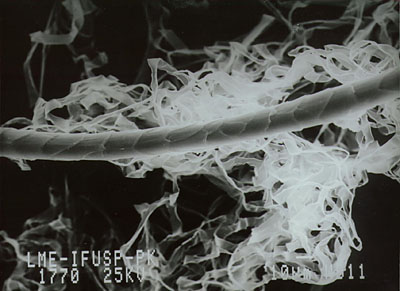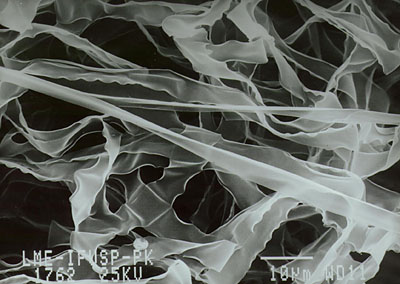Spiders have evolved to make the maximum use of that remarkable protein, silk. Silk can be used for many different purposes, such as retreats, cocoons, draglines, and snares. Although the web spiders have successfully made use of silk to capture prey, by so doing they have placed themselves in the rather difficult position picturesquely described by the French zoologists, André and Lamy (cited in Peakall, 1969). “Spiders lead lives bristling with difficulties and are always on the horns of a dreadful dilemma: no food without webs and no webs without food.”
Over time, spiders have evolved a wide range of silks with surprisingly different mechanical properties. Some companies are producing “artificial silk”, nowadays, and looking for possible technological applications of this material. Transgenic cows are producing some silk proteins in their milk!
The structure of the threads used by spiders for prey capture is always closely related to the spider's specific capture behavior. Capture threads are threads whose peculiar properties cause prey to adhere to them. With respect to these properties, two types of capture threads may generally be found in arachnological literature:
1) Capture threads whose suitability for holding prey is based upon a covering that consists of a viscous glue. These threads can be called gluey capture threads.
2) Capture threads whose suitability for holding prey is based upon a covering that consists of innumerable, extremely fine fibrils. They are often called hackled bands or hackled silk because of their characteristic appearance, or cribellate threads because the fibrils originate from a structure called cribellum. The physical basis of the stickiness of cribellar silk is still a matter of controversy.
During my doctoral studies on the behavior and ecology of brown spiders (Loxosceles spp.), I was amazed by the fact that the webs of brown spiders, which cover the substrate, are very efficient traps that can retain even flying insects, but these spiders don't produce either gluey or cribellate capture threads. Fortunately, I met Dr. Pedro Kyohara from the Electron Microscopy Lab of the Physics Institute, São Paulo State University. He became interested in observing the Loxosceles webs on SEM (JEOL JSM 840 A). Figure 1 shows some SEM photographs taken at Dr. Kyohara's lab.
We found that Loxosceles spiders produce a type of silk thread in ribbon shape (“ribbon-threads”), something that seems to be unique to this genus (Stern & Kullmann, 1981). This fact was ignored in most of the studies on Loxosceles, and the structures related to the production of the ribbon-threads were not identified. I proposed the term "fitas-de-sêda" to denominate the ribbon-threads in Portuguese (Ramires, 2000).
I could verify, by artificially pulling the silk from the spinnerets of restrained spiders under a stereo microscope, that the ribbon-threads are emitted from the single major ampullate gland spigots on the anterior lateral spinnerets. The ribbon-threads in the webs are generally found in great density, reeled amid the cylindrical threads. They can be folded longitudinally when stretched or partially to totally open and reeled when not stretched. The width range of the ribbon-threads is from 3 µm to 8 µm. The ribbon-threads produced by the three species of Brown spiders analyzed (Loxosceles laeta, L. gaucho and L. intermedia) are similar, but the density of the webs varies among the species. Samples of ribbon-threads artificially extracted from the spinnerets didn't differ in terms of the dimensions of the ribbon-threads found on the webs.
If you want to know more about spiders or look at other great microscopic images, visit the “Arachnology” site.
Comments to the author Eduardo Novaes Ramires (Tuiuti University, Paraná, Brazil) are welcomed.
References
PEAKALL, D. B. 1969. Synthesis of silk, mechanism and location. American Zoologist, 9: 71-79.
FOELIX, R. 1982. Biology of Spiders. Belknap Press of Harvard University Press, Cambridge, MA.
STERN, H. ; KULLMANN, E. 1981. Leben am seidenen Faden - Die rätselvolle Welt der Spinnen. München, Kindler Verlag.
RAMIRES, E. N. 2000. Produção de fios de sêda em forma de fita em aranhas do gênero Loxosceles (Sicariidae). Tuiuti: Ciência e Cultura 15: 11-17.
Figure 1 - SEM photographs of webs of Brown spiders (Loxosceles gaucho) a) 600x b) 1,200x.
(Click each image to view the author's master images; ca 1600x1100 pixels, 160 kbytes each. Images are copyright of the author.)

